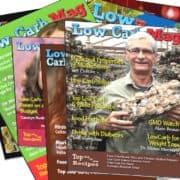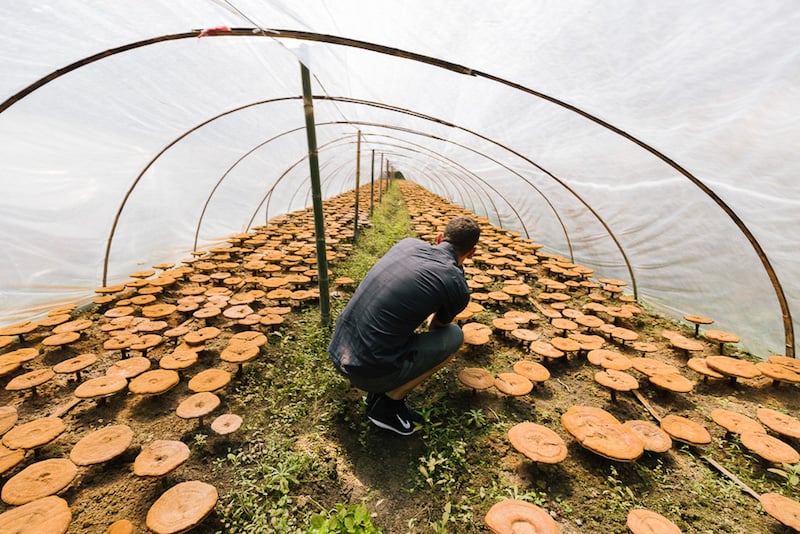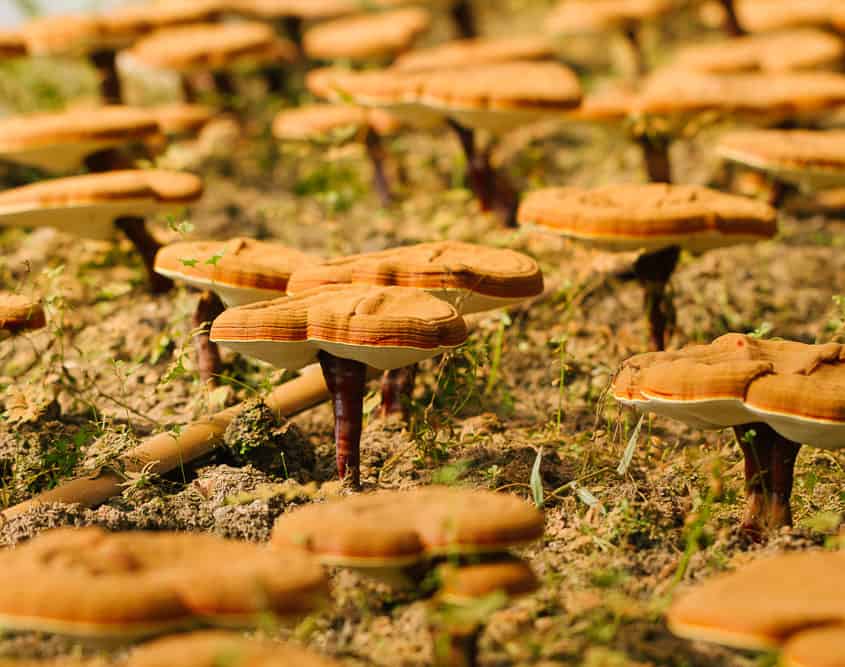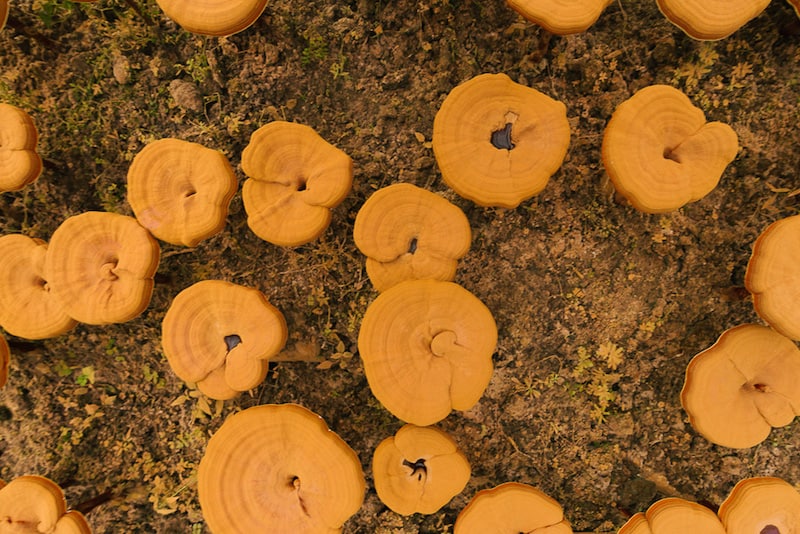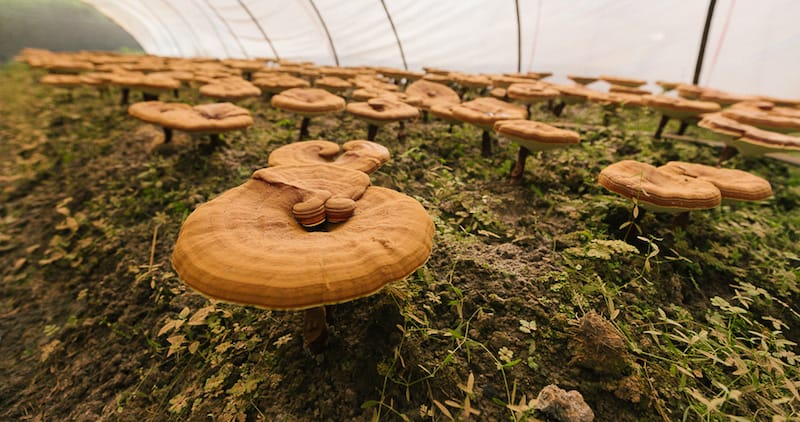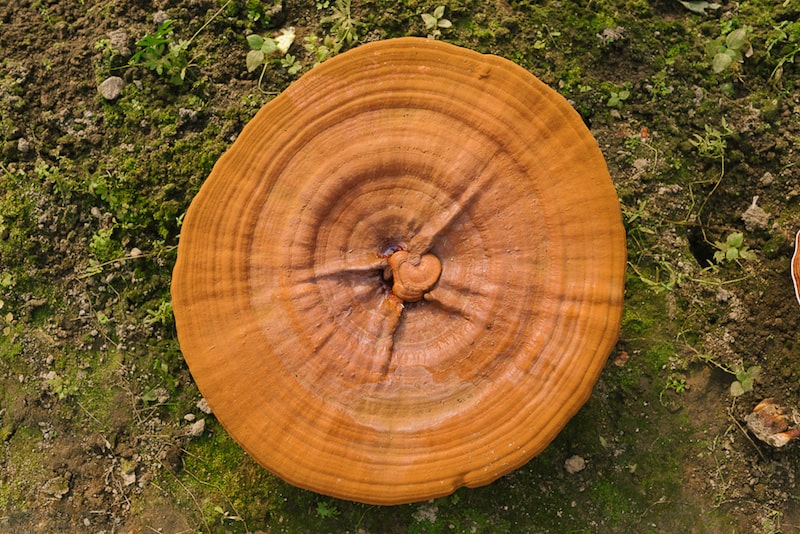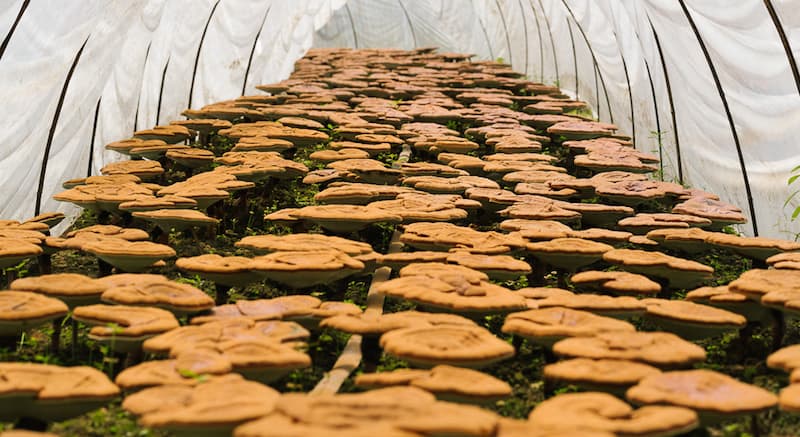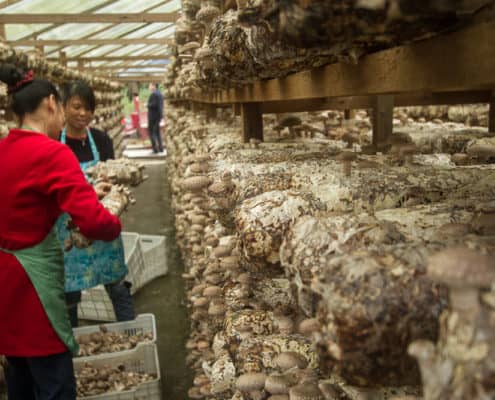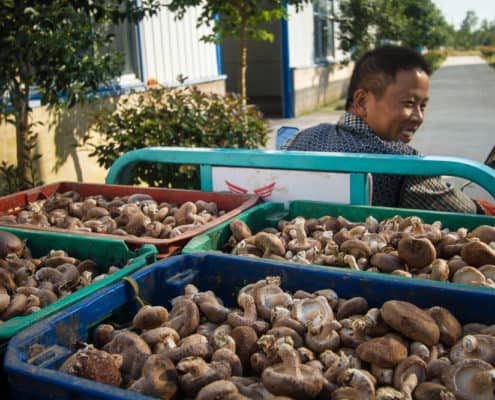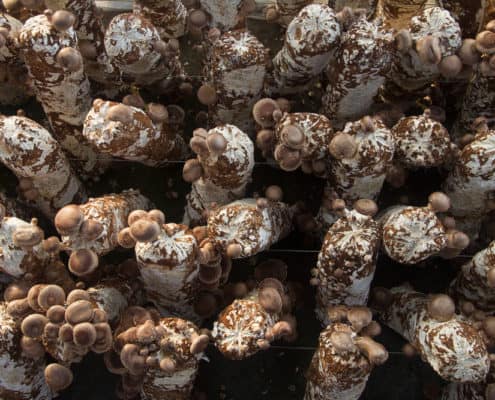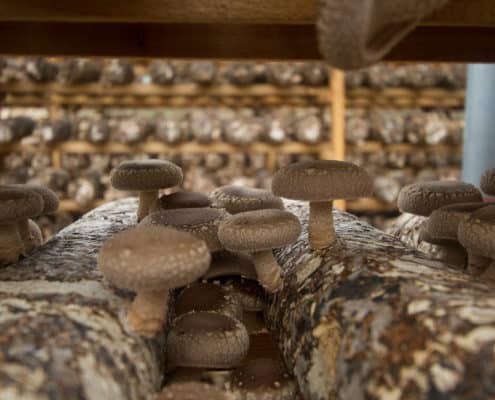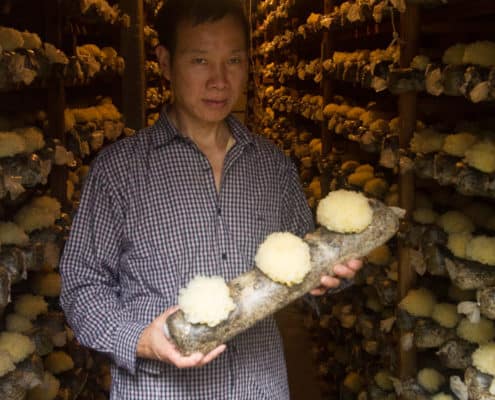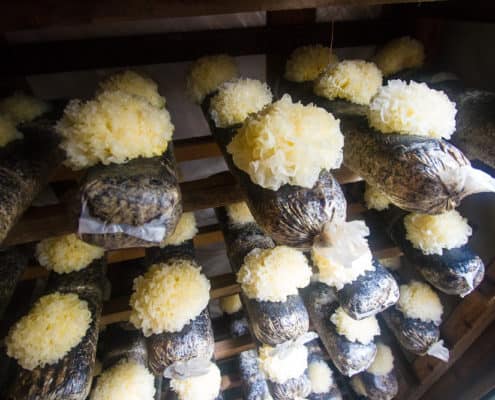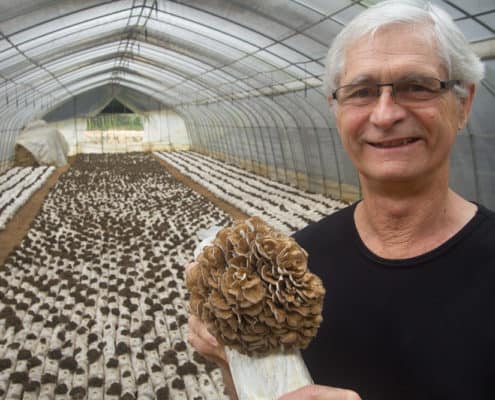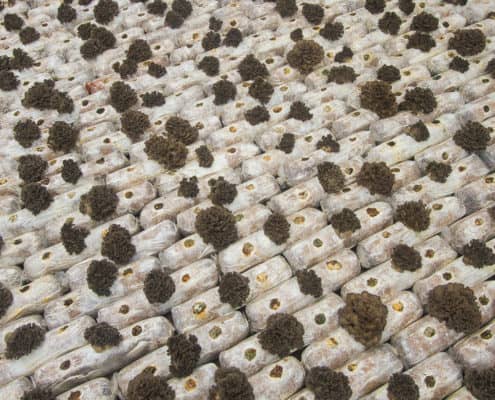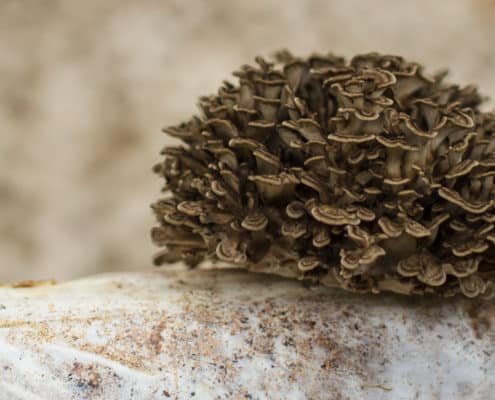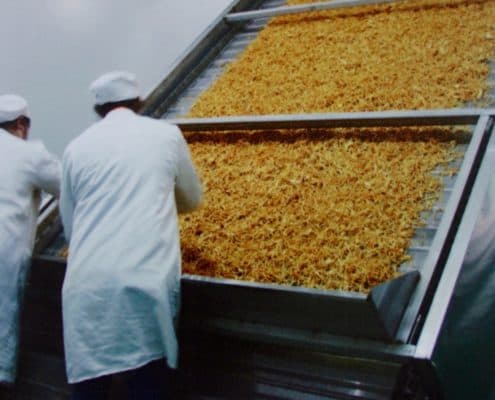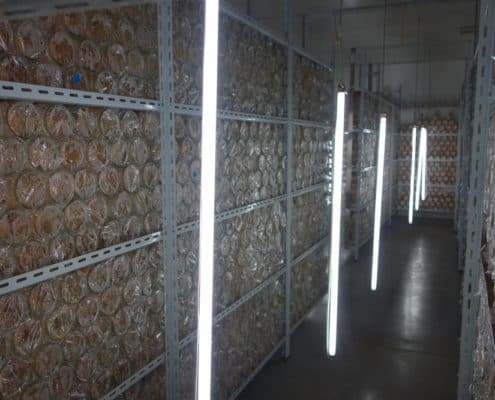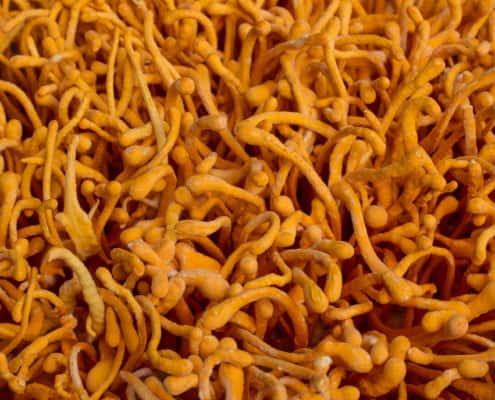China Adventures 2018 – The Reishi Harvest
Reishi is a warm temperature mushroom, growing and maturing during the summer in temperatures of 80F, and harvested in early September. With this in mind, we arrived in China on the first of September for our annual audit of mushroom farms. It had been a few years since we had visited reishi farms and we really wanted to see current practices.
Reishi is a very special species of mushroom. The botanical name for reishi is Ganoderma lucidum. Ganoderma means bright skin and lucidum refers to the shiny surface of this mushroom. So reishi is the mushroom with the shiny bright skin. That attribute along with the rams horn, spiral shaped cap make this mushroom one of the most beautifully distinctive of the medicinal species. (Please be aware that the botanical name has been changed to Ganoderma lingzhi)
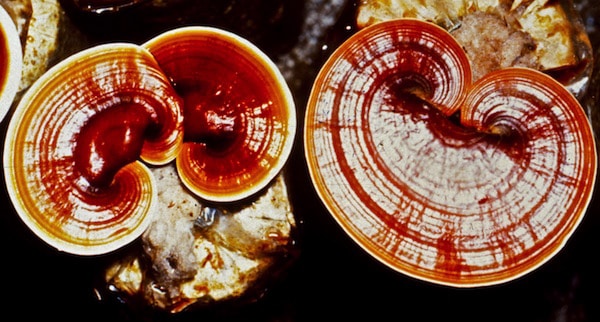
The beautiful spiral shape of reishi ©Nammex
Reishi is one of the few wood decomposing mushrooms that is grown in the ground. Due to this fact, reishi farms are often moved or fallowed after 2-3 years. This is possible and economical since there is often very little infrastructure other than simple greenhouses covered with shade cloth. So reishi grows in ambient temperatures with fresh air and fresh water, no artificial climate controlled rooms or grow houses.
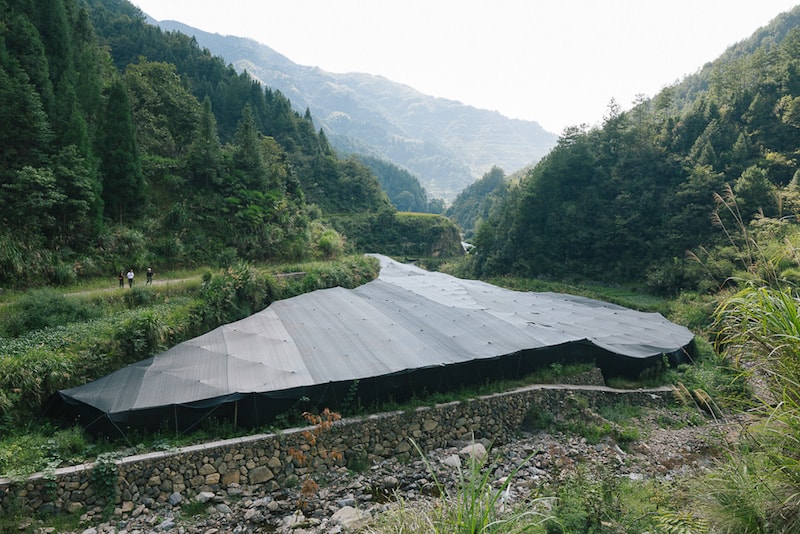
Organic Reishi Farm in China ©Nammex
The first farm was a 2 hour drive from the nearest small city and was located literally at the end of a road, far back into the mountains. A small, clean fresh water creek flowed by, adjacent to the shade houses. This was a new pristine location that was created in the spring of this year. Under the shade cloth were multiple smaller hoop-style plastic greenhouses. In general, the maturing reishi were growing on either side of a central path that allowed access from one end to the other.
This system of growing is now common throughout China. A pasteurized hardwood log is inoculated with the reishi spawn in January. Mushroom spawn is live mycelium on a carrier material, in this case, sawdust. By May, the log is fully colonized with the mycelium. At this time the log is placed in a long shallow earthen row. They are perfectly spaced to maximize the surface area of each row, and are now covered with a soil casing layer that will protect the logs from drying out and also supply water as the mushrooms grow. One or two mushrooms will be allowed to grow from each log and in order to achieve this, as the young mushrooms push through, they are meticulously pruned to insure the 2 mushroom per log standard.
We were able to visit four farms and review the harvest and the growing practices. We also spoke with the farmers and reviewed their practices and organic methods.
During our visit we also visited our friend, Dr. Edward Yang, of the Shanghai Normal University’s Institute of Immunology. I first met his father, Professor Yang Qing-yao back in the early 80’s and we had a very long and constructive friendship until his passing a few years ago. It was in this lab that Professor Yang developed turkey tail and was approved as a drug in China. With Edward’s help, we are doing some very interesting testing, which we’ll be able to tell you more about next year.

Left to right: Edward Yang, Skye Chilton, Jeff Chilton, Adam Chilton ©Nammex
Our yearly trips to China are always enjoyable, visiting new places and seeing old friends. And most of all, insuring that the quality of Nammex mushrooms and extracts continues to be the very best the world has to offer.
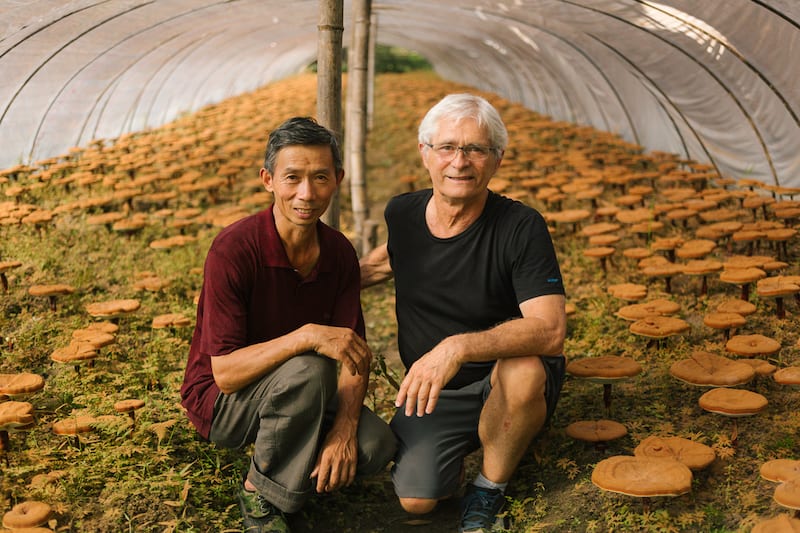
©Nammex
Journal of AOAC Notes Popularity of Beta-glucan Study
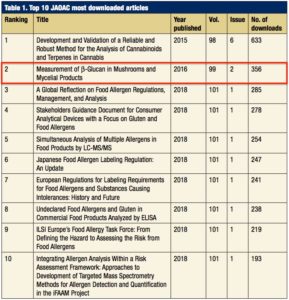 The July/August issue of Inside Laboratory Management, the Journal of AOAC International, has listed the peer reviewed article, Measurement of Beta-glucan in Mushrooms and Mycelial Products, as the second most downloaded article of 2017/2018. AOAC International is the governing body that sets the standards for analytical testing methods.
The July/August issue of Inside Laboratory Management, the Journal of AOAC International, has listed the peer reviewed article, Measurement of Beta-glucan in Mushrooms and Mycelial Products, as the second most downloaded article of 2017/2018. AOAC International is the governing body that sets the standards for analytical testing methods.
This research, carried out by Dr. Barry McCleary, one of the top experts in enzyme technologies, utilizes the Megazyme beta-glucan test to analyze products containing various species of mushroom and mycelium that are noted for their medicinal value.
Inside Laboratory Management noted the following about Dr. McCleary’s paper:
Along the same lines, in second position, an article focuses on a robust and reliable method developed for the measurement of β-glucan in mushroom and mycelial products. The medicinal properties of many species of mushroom have been valued and used in traditional Chinese medicine for centuries.
Driving interest in this second article are concerns within the regulatory community regarding health claims relating to nutritional supplements as well as the identity and purity of these products, and this relates particularly to medicinal mushrooms where the key active components have been identified as 1,3:1,6-β-glucan, triterpenoids, and ergosterol.
The results of McCleary’s research confirmed the analytical work published in the Nammex White Paper, Redefining Medicinal Mushrooms, and validated the Megazyme test as the most accurate test for (1-3)(1-6)-beta-glucan in mushrooms and yeast.
The beauty of the Megazyme beta-glucan test is that it also measures alpha-glucans, which includes glycogen, dextran, pullulan and starch. This reveals any potential carriers like maltodextrin, dextrose or in the case of myceliated grain products, starch.
Nammex worked with Dr. McCleary and supplied verified mushroom samples for this research.
It is now clear that the Megazyme beta-glucan method is the standard test for medicinal mushroom quality control. Mushroom and mycelium ingredients that do not measure beta-glucans should be questioned for their medicinal value.
Resources
United States Pharmacopeia research study confirms lack of triterpenes and beta-glucans in many Reishi products
In August, 2017, Nature, the worlds most cited scientific journal, published in its Scientific Reports an important analytical study about Reishi mushroom products. United States Pharmacopeial Convention (USP) sponsored this project with a leading mushroom scientist from China, Dr. Li Shao-ping. In their research, 19 different Reishi mushroom products sold in the USA were tested for the compounds that characterize a real Reishi mushroom (fruiting body). They used scientifically identified and validated Reishi mushrooms as their standard.
In the USP study, they utilized various highly accurate testing methods including HPTLC, Colorimetric method, GC-MS, and High Performance Size-exclusion Chromatography. The results of their study demonstrated clearly that only 5 of 19 samples could be verified as genuine Reishi mushroom. Most of the other products lacked characteristic triterpenoids and also had a starch-like polysaccharide profile that was inconsistent with Reishi mushroom.
During the study, Jeff Chilton, founder of Nammex, was in contact with USP and alerted the researchers to quality control issues including mycelium products that are grown on grain. Many of the samples they had purchased, which were sold and labeled as mushroom, were in fact mycelium on grain. More importantly, because of his long-standing work with mushrooms, Jeff was allowed to submit some Nammex Reishi mushroom extract samples.
USP made the following statement in the abstract of their research.
“ The results showed that the measured ingredients of only 5 tested samples (26.3%) were in accordance with their labels, which suggested the quality consistency of G. lucidum dietary supplements in the U.S. market was poor, which should be carefully investigated.”
3 out of the 5 samples (60%) that passed USP’s testing standards were Nammex reishi mushroom extracts.
The USP research has now confirmed what Jeff Chilton has demonstrated in his published 2015 White Paper, Redefining Medicinal Mushrooms, and his presentation to the International Society for Mushroom Science symposium in 2016.
Nammex commends USP for initiating this study and assisting the health and wellness industry with the validation of quality standards for mushroom products.
USP Research Article: https://www.nature.com/articles/s41598-017-06336-3 (Nature Scientific Reports 7, Article number: 7792(2017)
Jeff talks immunity and mushrooms in Nutraceuticals World
Medicinal Mushrooms Still Have Quality Issues: Interview by NutraIngredients-USA Science Editor Stephen Daniels
The North American medicinal mushroom market is expanding and Nammex is at the forefront. Because most health product companies understand green herbs but not mushrooms, much of what Nammex does is educational. Stephen Daniels discusses with Jeff the current issues facing the mushroom market and what role Nammex has played in the new trends in mushroom quality control.
After three years of detailed analysis of medicinal mushroom products, Nammex has developed a Fingerprinting Method for quality control of mushroom products. Our method is reshaping the current industry and helping drive awareness of the need for greater focus on defining product quality.
Jeff’s analytical initiative, starting with his groundbreaking White Paper, Redefining Medicinal Mushrooms, has rocked the industry all the way up to the American Herbal Products Association. AHPA, at the urging of new member companies, reviewed labeling claims and came up with a policy to help stem the confusion caused by mycelium on grain producers calling their products mushrooms. Stephen unpacks this policy initiative and other issues with Jeff and discusses what it ultimately means for businesses and end users.
We value the scientific basis for Stephen’s editorial focus and appreciate the time he took to discuss these issues with Jeff.
China Adventures 2016
Every year, my son, Skye and I travel to China to meet with our mushroom producing partners. The fall is a perfect time due to mild temperatures in central China and the arrival of the mushroom harvest. During the trip we will perform an audit of processing facilities and mushroom farms. Because there are multiple farms and different mushroom species are grown naturally according to ambient temperatures, we will see some species being harvested whereas other farms are still waiting for the first mature mushrooms to form.
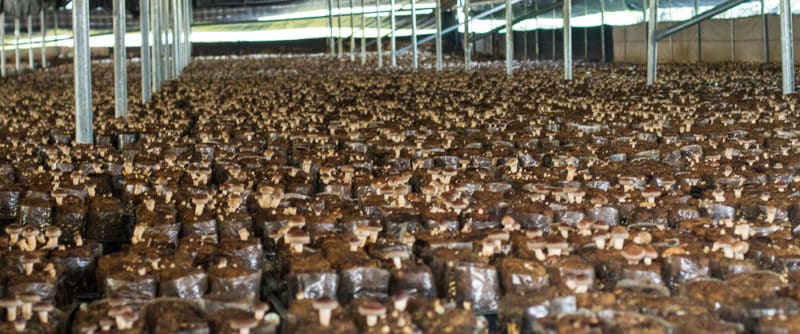
In 2015 we were able to view mature shiitake, maitake and auricularia farms and growing facilities. This year we were able to see shiitake, tremella and best of all, Cordyceps militaris. Most of the farms are clustered deep in the mountainous areas of Zhejiang and Fujian Province. These areas are the traditional heartland of Chinese mushroom growing. In fact, mushroom growing was first started in these areas in the 12th century and since then has grown into the largest agricultural crop in this part of China.
Today there are approximately a dozen mushrooms that are cultivated on a truly commercial scale. It is not an easy task to develop a mushroom cultivar that can economically produce a high quality yield of mushrooms. In fact, it takes decades of strain development and substrate testing to finally achieve positive results. That is why the cultivation of C. militaris is so special. As a mushroom grower, I am always very excited to see a new mushroom being cultivated. So to see C. militaris growing on a large scale with the substrate surface completely covered with fruiting bodies was a very satisfying experience for me.
But even more satisfying is the thought that for the first time, Cordyceps mushrooms are available in quantity at a price that completely eliminates the need for the overpriced, wildcrafted Caterpillar Fungus or even the 100% mycelium product called Cs-4. This is truly a revolutionary turn of events.
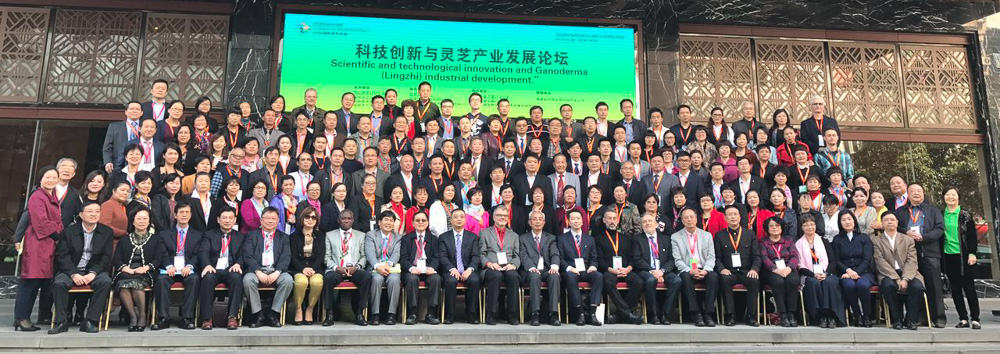
During our stay we traveled to the city of Fuzhou to attend the International Conference on Ganoderma Research. This was a gathering of top Chinese and International scientists presenting current research: analytical, in-vivo and in-vitro testing, and even historical reports. Of particular interest was the work on quality control in Ganoderma products. Utilizing an array of testing methods, fingerprints of the important active compounds were created and evaluated.
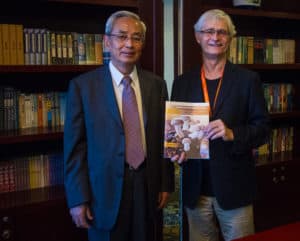
Jeff with Dr. Lin Zhi-Bin
The conference was headlined by quality control, Redefining Medicinal Mushrooms.
Dr. Lin delivered a keynote on the benefits of Ganoderma (Reishi), highlighting the primary benefits of reishi to be disease prevention. This is directly related to immunological modulation and positive effects on the homeostasis of endocrine, cardiovascular, and nervous systems. This is also why reishi is considered a genuine longevity herb.
Skye and I value our yearly trips to China and view them as the best way to insure high quality mushroom products for our customers.
Until next year,
– Jeff
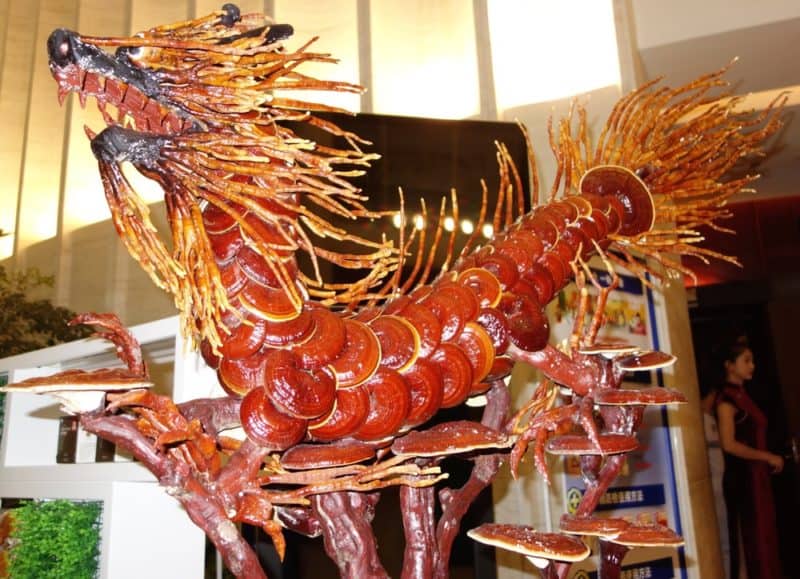
A Dragon on display at the International Conference on Ganoderma Research made entirely from Reishi.
Beta-glucan Content in Commercially Grown and Wild Mushrooms
German researchers Miriam Sari and Jan Lelley have recently published a new research paper in the Journal of Food Chemistry entitled “Screening of beta-glucan contents in commercially cultivated and wild growing mushrooms“. This paper looks at the beta-glucan content in commercially grown and wild mushrooms. Where possible they also looked at the beta-glucan content in the cap and stem to see if there were any differences.
The commercially grown mushrooms were purchased from local supermarkets or local growers in Germany. Wild specimens were collected from the western part of North-Rhine Westphalia, Germany.
The Megazyme beta-glucan method was used to determine the beta-glucan and alpha-glucan content of all samples.
The results showed some interesting results for the amount of beta-glucans in the cap vs the stem. Most samples showed more beta-glucans in the stem than the cap. For example, The Porcini (Boletus edulis) stalk measured a whopping 57.9% beta-glucans with the cap only coming in at 16.88%.
As the stem is often tougher, more fibrous and undesirable when compared to the cap, it is often removed during the harvesting process. Many of us also cut the stems off the mushrooms we buy from the supermarkets. Whether it’s extracting them or using them for culinary purposes, the data indicates that the stems should be utilized in one way or another for their valuable beta-glucan content.
Mushrooms to note for their high beta-glucan content are Turkey Tail (Trametes versicolor), Chicken of the Woods (Laetiporus sulphurous), Trembling Merulius (Phlebia tremellosa) and Birch Polypore (Piptoporus betulinus) which all show beta-glucan content around 50% with Turkey Tail leading the pack at 60.79%.
Here is the full table of results:
Jeff Chilton Presents Ground Breaking Research at ISMS 2016
On June 1st, 2016, Jeff presented his research that was published in Redefining Medicinal Mushrooms, which created a new testing protocol for qualifying functional mushroom products.
In one example, he highlights reishi to clearly demonstrate the differences in beta-glucans for whole reishi mushrooms and reishi mycelium grown on grain. The results were as follows:
| Beta-glucans | Alpha-glucans | Ergosterol | |
| Reishi Mushroom | 30.5% | 0.37% | 0.1% |
| Reishi Mycelium on Grain | 6.56% | 40.77% | 0.01% |
The testing results illustrate that residual grain from mycelium products increases alpha-glucans (starch) and lowers the beta-glucans and ergosterol. Ergosterol is the sterol that is a prime indicator of degree of fungal presence in any material. It is also the pre-cursor to vitamin D2.
Full Presentation
Presentation Slides
ISMS Published Paper
Follow Up Questions
At the end of Jeff’s presentation, there were 2 questions from Paul Stamets of Fungi Perfecti. This company sells mycelium on grain products.
1. Dr. McCleary’s recent paper on the Megazyme Beta-glucan test method found almost 2x more beta-glucans in reishi mushroom than previous test findings. How can this test method be accurate with such a wide variance of test results?
Jeff responded that Dr. McCleary’s paper was a detailed evaluation of the Megazyme beta-glucan method as well as a review of beta-glucan methods published by other mushroom researchers – Manzi and Molleken specifically. Dr. McCleary clearly elucidated the reasons why the methods used by Manzi and Molleken were not accurate.
When he re-evaluated his own Megazyme test method, he discovered that sulfuric acid was a better solvent than HCl for the procedure. Although sulfuric acid had no effect on most of the mushroom samples, it had a dramatic effect on reishi, increasing the beta-glucan result. Because of this finding, Dr. McCleary now recommends using sulfuric acid when running the Megazyme method.
This finding demonstrates why scientists such as Dr. McCleary publish in peer-reviewed journals and report their findings for the betterment of science. So the answer to Mr. Stamets’ question is that the method has been improved and best of all, reishi is actually higher in beta-glucans than originally believed.
Dr. McCleary’s paper was published in the peer reviewed Journal of the Association of Official Analytical Chemists International, the body that validates analytical methods used in scientific research and industry. So the Megazyme method has now been peer reviewed.
2. How does the Megazyme method differentiate between mould mycelium and basidiomycete mycelium?
The Megazyme method is not designed to differentiate fungal species. Microbiological testing can accomplish this if the microbes are alive. In order to discover if other fungal species are present, Nammex sends the sample out for DNA analysis. This accurately determines what organisms are in the sample, so if mold or other plants are present, they will show up in the DNA analysis. Likewise, if a product is spiked by yeast, grain starches, or other adulterants, they will also show up.
Mushroom Growers Newsletter Weighs in on Beta-Glucan Testing
The Mushroom Growers Newsletter recently showcased the recent peer-reviewed paper from Dr. McCleary titled “Measurement of β-Glucan in Mushrooms and Mycelial Products”.
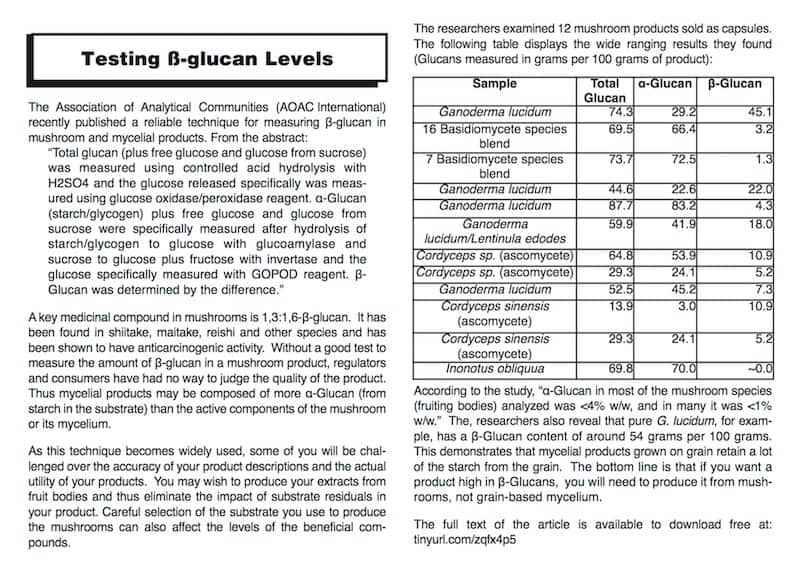
In it they state the following:
A key medicinal compound in mushrooms is 1,3:1,6-β-glucan. It has been found in shiitake, maitake, reishi and other species and has been shown to have anticarcinogenic activity. Without a good test to measure the amount of β-glucan in a mushroom product, regulators and consumers have had no way to judge the quality of the product. Thus mycelial products may be composed of more α-Glucan (from starch in the substrate) than the active components of the mushroom or its mycelium.
As this technique becomes widely used, some of you will be challenged over the accuracy of your product descriptions and the actual utility of your products. You may wish to produce your extracts from fruit bodies and thus eliminate the impact of substrate residuals in your product. Careful selection of the substrate you use to produce the mushrooms can also affect the levels of the beneficial compounds.
And goes on to say:
This demonstrates that mycelial products grown on grain retain a lot of the starch from the grain. The bottom line is that if you want a product high in β-Glucans, you will need to produce it from mushrooms, not grain-based mycelium.
We couldn’t agree more.
mushrooms
Nammex
Box 1780
Gibsons, BC
Canada, V0N 1V0
t: 604.886.7799
e:

